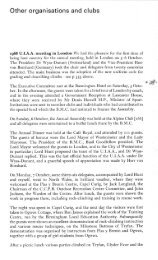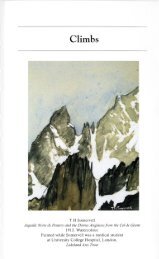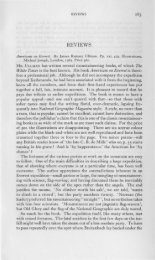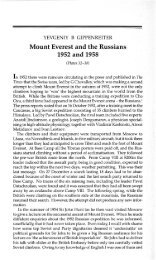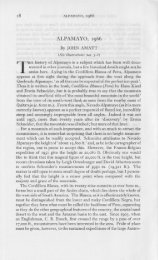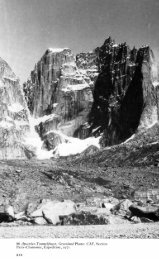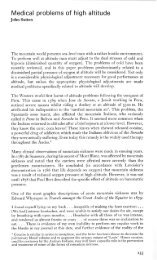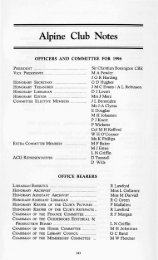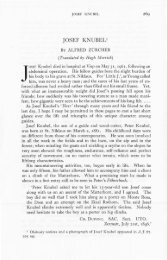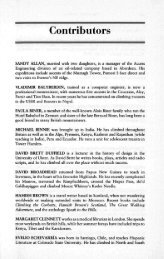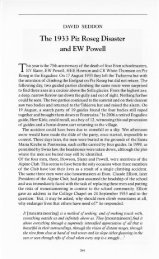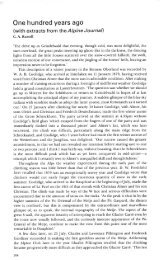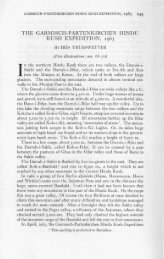AJ 2002 222-229 Ward Pundits.pdf - Alpine Journal
AJ 2002 222-229 Ward Pundits.pdf - Alpine Journal
AJ 2002 222-229 Ward Pundits.pdf - Alpine Journal
You also want an ePaper? Increase the reach of your titles
YUMPU automatically turns print PDFs into web optimized ePapers that Google loves.
224<br />
THE ALPINE JOURNAL <strong>2002</strong><br />
few permanent inhabitants; but in the summer nomadic Kyrghyz graze<br />
their flocks of yak, horses, sheep and goats, and it is here that the famous<br />
Marco Polo sheep are found, as well as wild camels. The area is traversed<br />
by the Oxus river.<br />
The Mirza<br />
To find a suitable pundit, Montgomerie looked for a man who had traded<br />
in the region, who spoke the local languages and whose religion was similar<br />
to that of the local people. It was a risky assignment and suitable candidates<br />
were few. His choice finally fell on Mirza Shuza, whose mother was Persian<br />
and whose father was a Turkish trader based on Meshed, where the Mirza<br />
was born. He was already known to the Survey, where he had learned the<br />
basic techniques of surveying, but he remained in Kabul for a decade in the<br />
service of the Emir of Afghanistan. On his return, in 1867, he was given a<br />
refresher course and posted to Peshawar where he started his first survey in<br />
1868. His objective was to reach Kashgar, exploring on the way the Upper<br />
Oxus, the Pamir, and various routes to Yarkand. He was disguised as a<br />
merchant, taking with him a number of pack animals.<br />
As the passes over the mountains were blocked by winter snow, the Mirza<br />
had to make four attempts before reaching Kandahar. Since a civil war was<br />
raging, he joined Sher Ali's army which was marching north to Kabul where<br />
he arrived at the end of June. He described the town as being in a 'fIlthy<br />
condition not pleasant either to the nose or eye', and he was glad to leave.<br />
His next stop was at Kulm-Tashkurgan, from which he gained his first<br />
glimpse of the Oxus river. Eventually he reached Faizabad and presented<br />
himself to the court of the Mir. Despite being denounced as an English spy,<br />
he talked and bribed his way out of a tricky situation and left on 24 December<br />
1868. He reached the Oxus at the mud forts of Kila Punja, just upstream<br />
from where the Oxus divides. He chose to explore the southern tributary,<br />
which was fortuitous as, some years before, Wood had explored the northern<br />
tributary, and thus Montgomerie and the Survey were provided with details<br />
of the drainage of the whole of the Upper Oxus.<br />
However, the most difficult part of his journeylay ahead - a 12-day march<br />
through the Wakhan valley and then across the Pamir, with no food available<br />
for eight days beyond the last village. Despite ferocious winter gales, he<br />
continued his survey, crossed the Pamir and reached Tashkurgan in the<br />
Sirikol valley. Meeting the governor, the Mirza was forced to accept an<br />
escort. Now on unsurveyed ground, he passed through Yangi Hissar on his<br />
way to Kashgar and passed close to three unknown mountains: Kongur,<br />
Kongur Tiube and Mustagh Ata (Tagharma).<br />
Russian influence was strong in Kashgar where they had had a consulate<br />
since 1860. In 1869 the local war lord, Yakub Beg, was at the height of his<br />
powers, and his lieutenant was very suspicious of the Mirza.<br />
As soon as he arrived he learned about the two Englishmen, Shaw and<br />
Hayward, who had been detained in the province. The Mirza tried to contact



